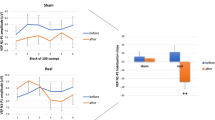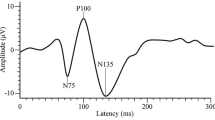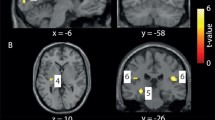Abstract
The objective is to update and extend previous results of a systematic review of the literature with meta-analysis performed to determine the prevalence of phosphenes and the phosphene threshold (PT) values obtained during single-pulse transcranial magnetic stimulation (TMS) in adults with migraine. Both published and unpublished controlled studies measuring PT by single-pulse TMS in adults with migraine with or without aura (MA, MwA) were systematically reviewed. Prevalence of phosphenes and PT values were assessed calculating mean difference (MD) and odds ratio (OR) with 95 % confidence intervals (CI). Fifteen trials (369 migraine patients and 269 controls), were included. Patients with MA had a statistically significant lower PT compared with controls when a circular coil was used (MD: −22.27, 95 % CI −33.44 to −11.10); with a figure-of-eight coil the difference was not statistically significant. There was a significant higher phosphene prevalence in MA compared with controls (OR: 3.57, 95 % CI 1.16–10.94). No significant differences were found either in phosphene reporting between patients with MwA and controls, or in PT values obtained by figure-of-eight coil in subjects with MwA versus controls. In general, these results slightly support the hypothesis of a primary visual cortex hyper-excitability in MA, providing not enough evidence for MwA. A significant heterogeneity across studies probably reflects relevant clinical and methodological heterogeneity.


Similar content being viewed by others
References
Welch KMA, D’Andrea G, Tepley N, Barkley G, Ramadan NM (1990) The concept of migraine as a state of central neuronal hyperexcitability. Neurol Clin 8:817–828
Welch KM, Barkeley GL, Tepley N, Ramadan NM (1993) Central neurogenic mechanisms of migraine. Neurology 43(Suppl 3):S21–S25
Shepherd AJ (2001) Increased visual after-effects following pattern adaptation in migraine: a lack of intracortical excitation? Brain 124:2310–2318
Lehtonen JB (1974) Visual evoked cortical potentials for single flashes and flickering light in migraine. Headache 14:1–12
Connolly JF, Gawel M, Rose FC (1982) Migraine patients exhibit abnormalities in the visual evoked potential. J Neurol Neurosurg Psychiatry 45:464–467
Diener HC, Scholz E, Dichgans J et al (1989) Central effects of drugs used in migraine prophylaxis evaluated by visual evoked potentials. Ann Neurol 25:125–130
Amassian VE, Cracco RQ, Maccabee PJ, Rudell A, Eberle L (1989) Suppression of visual perception by magnetic coil stimulation of human occipital cortex. Electroencephalogr Clin Neurophysiol 74:458–462
Meyer BU, Diehl R, Steinmetz H, Britton TC, Benecke R (1991) Magnetic stimuli applied over motor and visual cortex: influence of coil position and field polarity on motor response, phosphenes and eye movements. Electroencephalogr Clin Neurophysiol 43(Suppl 1):21–134
Ambrosini A, Schoenen J (2003) The electrophysiology of migraine. Curr Opin Neurol 16:327–331
Schoenen J, Ambrosini A, Sándor PS, Maertens de Noordhout A (2003) Evoked potentials and transcranial magnetic stimulation in migraine: published data and viewpoint on their pathophysiologic significance. Clin Neurophysiol 114:955–972
Fumal A, Bohotin V, Vandenheede M, Schoenen J (2003) Transcranial magnetic stimulation in migraine: a review of facts and controversies. Acta Neurol Belg 103:144–154
Schoenen J (2006) Neurophysiological features of the migrainous brain. Neurol Sci 27(Suppl 2):S77–S81
Brigo F, Storti M, Nardone R, Fiaschi A, Bongiovanni LG, Tezzon F, Manganotti P (2012) Transcranial magnetic stimulation of visual cortex in migraine patients: a systematic review with meta-analysis. J Headache Pain 13:339–349
International Headache Society (1988) Classification and diagnostic criteria for headache disorders, cranial neuralgia and facial pain. Cephalalgia 8(Suppl 7):1–96
Headache Classification Subcommittee of the International Headache Society (2004) The International Classification of Headache Disorders: 2nd edition. Cephalalgia 24(Suppl 1):9–160
Higgins JP, Thompson SG, Deeks JJ, Altman DG (2003) Measuring inconsistency in meta-analyses. BMJ 327:557–560
Brighina F, Piazza A, Daniele O, Fierro B (2002) Modulation of visual cortical excitability in migraine with aura: effects of 1 Hz repetitive transcranial magnetic stimulation. Exp Brain Res 145:177–181
Battelli L, Black KR, Wray SH (2002) Transcranial magnetic stimulation of visual area V5 in migraine. Neurology 58:1066–1069
Young WB, Oshinsky ML, Shechter AL, Gebeline-Myers C, Bradley KC, Wassermann EM (2004) Consecutive transcranial magnetic stimulation: phosphene thresholds in migraineurs and controls. Headache 44(2):131–135
Antal A, Arlt S, Nitsche MA, Chadaide Z, Paulus W (2006) Higher variability of phosphene thresholds in migraineurs than in controls: a consecutive transcranial magnetic stimulation study. Cephalalgia 26:865–870
Aurora SK, Barrodale P, Chronicle EP, Mulleners WM (2005) Cortical inhibition is reduced in chronic and episodic migraine and demonstrates a spectrum of illness. Headache 45:546–552
Bohotin V, Fumal A, Vandenheede M, Gérard P et al (2002) Effects of repetitive transcranial magnetic stimulation on visual evoked potentials in migraine. Brain 125:912–922
Cappellari A, Zago S, Valli G, Ferrucci R, De Benedittis G (2011) Magnetophosphenes in migraineurs: failure to find a cortical hyper- or hypoexcitability by single-pulse transcranial magnetic stimulation.(as supplied June 2011)
Aurora SK, Al-Sayed F, Welch KM (1999) The threshold for magnetophosphenes is lower in migraine. Neurology 52:A472
Bohotin V, Fumal A, Vandenheede M, Bohotin C, Schoenen J (2003) Excitability of visual V1–V2 and motor cortices to single transcranial magnetic stimuli in migraine: a reappraisal using a figure-of-eight coil. Cephalalgia 23:264–270
Gunaydin S, Soysal A, Atay T, Arpaci B (2006) Motor and occipital cortex excitability in migraine patients. Can J Neurol Sci 33:63–67
Aurora SK, Welch KM, Al-Sayed F (2003) The threshold for phosphenes is lower in migraine. Cephalalgia 23:258–263
Gerwig M, Niehaus L, Kastrup O, Stude P, Diener HC (2005) Visual cortex excitability in migraine evaluated by single and paired magnetic stimuli. Headache 45:1394–1399
Mulleners WM, Chronicle EP, Palmer JE, Koehler PJ, Vredeveld JW (2001) Visual cortex excitability in migraine with and without aura. Headache 41:565–572
Aurora SK, Ahmad BK, Welch KM, Bhardhwaj P, Ramadan NM (1998) Transcranial magnetic stimulation confirms hyperexcitability of occipital cortex in migraine. Neurology 50:1111–1114
Aurora SK, Cao Y, Bowyer SM, Welch KM (1999) The occipital cortex is hyperexcitable in migraine: experimental evidence. Headache 39:469–476
Áfra J, Mascia A, Gérard P, Maertens de Noordhout A, Schoenen J (1998) Interictal cortical excitability in migraine: a study using transcranial magnetic stimulation of motor and visual cortices. Ann Neurol 44:209–215
Aguggia M, Zibetti M, Febbraro A, Mutani R (1999) Transcranial magnetic stimulation in migraine with aura: further evidence of occipital cortex hyperexcitability. Cephalalgia 19:465
Valli G, Cappellari A, Zago S, Ciammola A, De Benedittis G (2001) Is migraine associated with hyperexcitability of the occipital cortex? A transcranial magnetic stimulation controlled study. Neurology 56:A142
Valli G, Cappellari A, Zago S, Ciammola A, De Benedittis G (2002) Migraine is not associated with hyperexcitability of the occipital cortex. A transcranial magnetic stimulation controlled study. In: Proceedings of the 10th World Congress of Pain, Seattle. IASP PRESS. 1580-P128, 525
Khedr EM, Ahmed MA, Mohamed KA (2006) Motor and visual cortical excitability in migraineurs patients with or without aura: transcranial magnetic stimulation. Neurophysiol Clin 36:13–18
Kropp P, Gerber WD (1998) Prediction of migraine attacks using a slow cortical potential, the contingent negative variation. Neurosci Lett 257:73–76
Evers S, Quibeldey F, Grotemeyer KH, Suhr B, Husstedt IW (1999) Dynamic changes of cognitive habituation and serotonin metabolism during the migraine interval. Cephalalgia 19:485–491
Áfra J, Sandor PS, Schoenen J (2000) Habituation of visual and intensity dependence of auditory evoked cortical potentials tend to normalize just before and during the migraine attack. Cephalalgia 20:714–719
Smith MJ, Keel JC, Greenberg BD et al (1999) Menstrual cycle effects on cortical excitability. Neurology 53:2069–2072
Smith MJ, Adams LF, Schmidt PJ, Rubinow DR, Wassermann EM (2002) Effects of ovarian hormones on human cortical excitability. Ann Neurol 51:599–603
Young WB, Oshinsky ML, Shechter AL, Wassermann EM (2001) Consecutive transcranial magnetic stimulation induced phosphene thresholds in migraineurs and controls. Neurology 56:A142
Boros K, Poreisz C, Paulus W, Antal A (2009) Does the menstrual cycle influence the motor and phosphene thresholds in migraine? Eur J Neurol 16:367–374
Cohen LG, Roth BJ, Nilsson J et al (1990) Effects of coil design on delivery of focal magnetic stimulation. Technical considerations. Electroencephalogr Clin Neurophysiol 75:350–357
Hallett M (2000) Transcranial magnetic stimulation and the human brain. Nature 406:147–150
Acknowledgments
We are in debt with Dr. Stefano Zago (Department of Neurological Sciences, University of Milan, Italy), who kindly provided us information on a still unpublished work (Cappellari), thus allowing us to include also this study in the meta-analysis. We also thank Dr. Sheena Aurora for providing us useful additional information on her works.
Conflict of interest
The authors declare that there is no conflict of interest.
Author information
Authors and Affiliations
Corresponding author
Appendix: Search strategies used in the review
Appendix: Search strategies used in the review
MEDLINE:
((“Migraine Disorders”[Mesh]) OR migrain* OR migraine) AND (“Phosphenes”[Mesh]) OR phosphen* OR “phosphene treshold”) AND “Transcranial Magnetic Stimulation”[Mesh])): 94 results
EMBASE:
(migrain* AND phosphen* AND “Transcranial Magnetic Stimulation”): 34 results
Rights and permissions
About this article
Cite this article
Brigo, F., Storti, M., Tezzon, F. et al. Primary visual cortex excitability in migraine: a systematic review with meta-analysis. Neurol Sci 34, 819–830 (2013). https://doi.org/10.1007/s10072-012-1274-8
Received:
Accepted:
Published:
Issue Date:
DOI: https://doi.org/10.1007/s10072-012-1274-8




